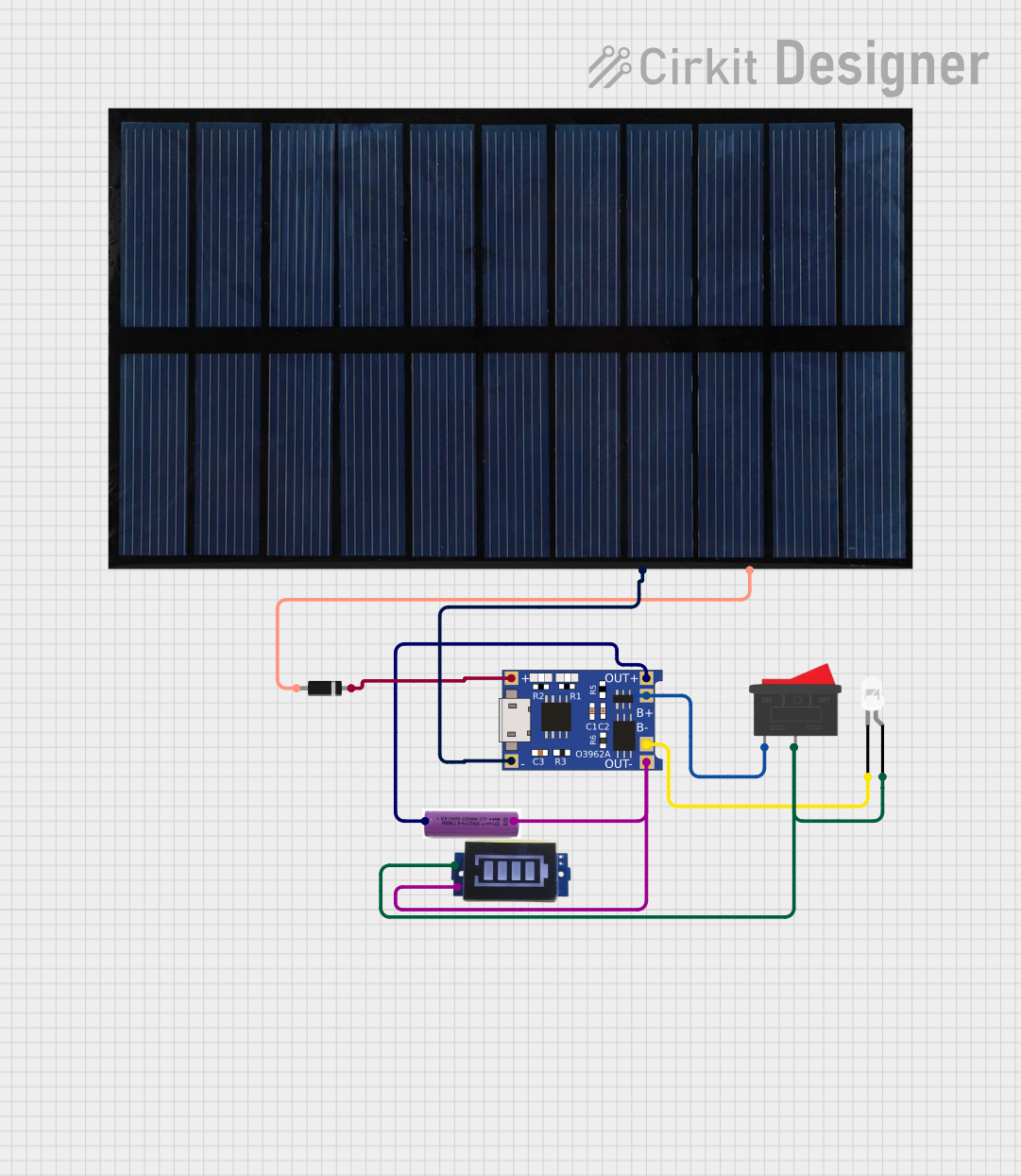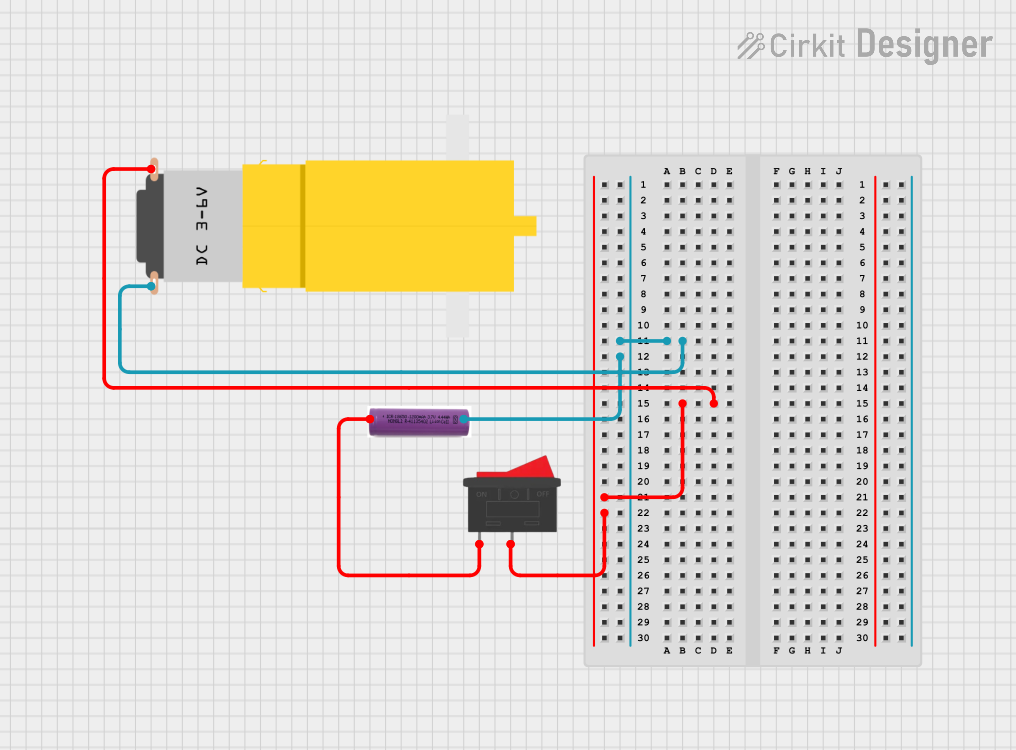
How to Use 3.7V Battery: Examples, Pinouts, and Specs

 Design with 3.7V Battery in Cirkit Designer
Design with 3.7V Battery in Cirkit DesignerIntroduction
The 3.7V battery is a rechargeable lithium-ion battery widely used in portable electronic devices such as smartphones, tablets, wearables, and DIY electronics projects. It provides a nominal voltage of 3.7 volts and is known for its high energy density, lightweight design, and long cycle life. This battery is an essential component for powering low-voltage circuits and devices requiring reliable and rechargeable power sources.
Explore Projects Built with 3.7V Battery

 Open Project in Cirkit Designer
Open Project in Cirkit Designer
 Open Project in Cirkit Designer
Open Project in Cirkit Designer
 Open Project in Cirkit Designer
Open Project in Cirkit Designer
 Open Project in Cirkit Designer
Open Project in Cirkit DesignerExplore Projects Built with 3.7V Battery

 Open Project in Cirkit Designer
Open Project in Cirkit Designer
 Open Project in Cirkit Designer
Open Project in Cirkit Designer
 Open Project in Cirkit Designer
Open Project in Cirkit Designer
 Open Project in Cirkit Designer
Open Project in Cirkit DesignerCommon Applications and Use Cases
- Powering portable electronic devices (e.g., smartphones, cameras, and Bluetooth speakers)
- DIY electronics projects and prototyping
- Robotics and IoT devices
- Backup power supplies for small systems
- Wearable technology
Technical Specifications
The following table outlines the key technical details of a typical 3.7V lithium-ion battery:
| Parameter | Value |
|---|---|
| Nominal Voltage | 3.7V |
| Fully Charged Voltage | 4.2V |
| Discharge Cutoff Voltage | 2.5V–3.0V (varies by manufacturer) |
| Capacity Range | 500mAh to 5000mAh (varies by model) |
| Chemistry | Lithium-Ion |
| Maximum Discharge Current | 1C to 3C (varies by model) |
| Charging Current | 0.5C to 1C (recommended) |
| Operating Temperature | -20°C to 60°C |
| Cycle Life | 300–500 cycles (typical) |
Pin Configuration and Descriptions
Most 3.7V batteries have two terminals: positive (+) and negative (-). Some batteries may include additional pins for protection circuitry or temperature monitoring. Below is a general description:
| Pin | Label | Description |
|---|---|---|
| 1 | + | Positive terminal for power output |
| 2 | - | Negative terminal for power output |
| 3 (optional) | T | Temperature monitoring pin (if included) |
Usage Instructions
How to Use the 3.7V Battery in a Circuit
- Identify the Terminals: Locate the positive (+) and negative (-) terminals on the battery.
- Connect to the Load: Connect the positive terminal to the positive input of your circuit and the negative terminal to the ground (GND).
- Use a Protection Circuit: Lithium-ion batteries are sensitive to overcharging, over-discharging, and short circuits. Always use a battery protection circuit module (PCM) or a battery management system (BMS) to ensure safe operation.
- Charging the Battery: Use a dedicated lithium-ion battery charger with a constant current/constant voltage (CC/CV) charging profile. Ensure the charger outputs a maximum of 4.2V and adheres to the recommended charging current (typically 0.5C to 1C).
Important Considerations and Best Practices
- Avoid Overcharging: Never charge the battery above 4.2V, as this can cause overheating or damage.
- Prevent Over-Discharging: Do not allow the battery voltage to drop below the discharge cutoff voltage (2.5V–3.0V).
- Temperature Safety: Avoid exposing the battery to extreme temperatures, as this can degrade performance or cause safety hazards.
- Storage: Store the battery at a partial charge (around 40–60%) in a cool, dry place if not in use for extended periods.
- Polarity: Double-check the polarity before connecting the battery to a circuit to avoid damage.
Example: Using a 3.7V Battery with an Arduino UNO
To power an Arduino UNO with a 3.7V battery, you will need a DC-DC boost converter to step up the voltage to 5V. Below is an example circuit and code:
Circuit Setup
- Connect the positive terminal of the 3.7V battery to the input (+) of the DC-DC boost converter.
- Connect the negative terminal of the battery to the input (-) of the boost converter.
- Connect the output (+) of the boost converter to the Arduino UNO's 5V pin.
- Connect the output (-) of the boost converter to the Arduino UNO's GND pin.
Arduino Code Example
// Example code to blink an LED connected to pin 13 on the Arduino UNO
// Ensure the Arduino is powered via the 3.7V battery and boost converter
void setup() {
pinMode(13, OUTPUT); // Set pin 13 as an output pin
}
void loop() {
digitalWrite(13, HIGH); // Turn the LED on
delay(1000); // Wait for 1 second
digitalWrite(13, LOW); // Turn the LED off
delay(1000); // Wait for 1 second
}
Troubleshooting and FAQs
Common Issues and Solutions
Battery Not Charging
- Cause: Faulty charger or incorrect charging voltage.
- Solution: Verify the charger outputs 4.2V and is compatible with lithium-ion batteries.
Battery Drains Quickly
- Cause: High load current or degraded battery capacity.
- Solution: Check the load current and replace the battery if it has reached the end of its cycle life.
Battery Overheats
- Cause: Overcharging, short circuit, or high discharge current.
- Solution: Use a protection circuit and ensure the battery is not exposed to excessive current or heat.
Device Does Not Power On
- Cause: Incorrect polarity or insufficient voltage.
- Solution: Verify the battery connections and ensure the voltage meets the device's requirements.
FAQs
Q: Can I use a 3.7V battery without a protection circuit?
A: It is not recommended. A protection circuit ensures safe operation by preventing overcharging, over-discharging, and short circuits.
Q: How do I know when the battery is fully charged?
A: A fully charged 3.7V battery will reach a voltage of approximately 4.2V.
Q: Can I connect multiple 3.7V batteries in series or parallel?
A: Yes, but ensure you use a proper battery management system (BMS) to balance the cells and prevent overcharging or over-discharging.
Q: How long does a 3.7V battery last?
A: The lifespan depends on the usage and charging cycles. Typically, it lasts 300–500 charge cycles under normal conditions.